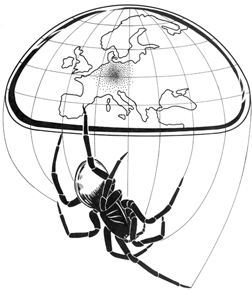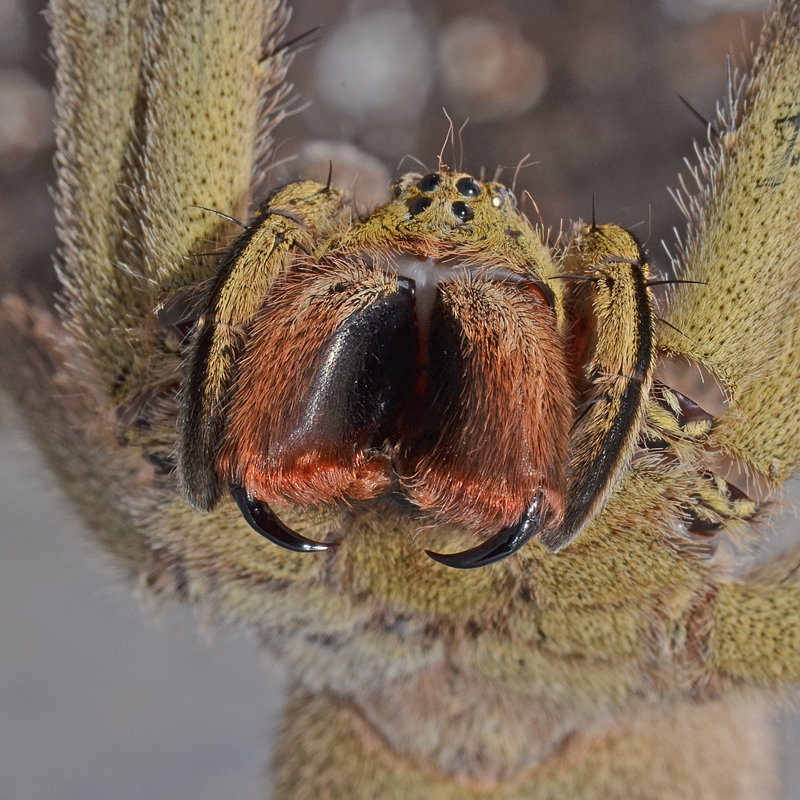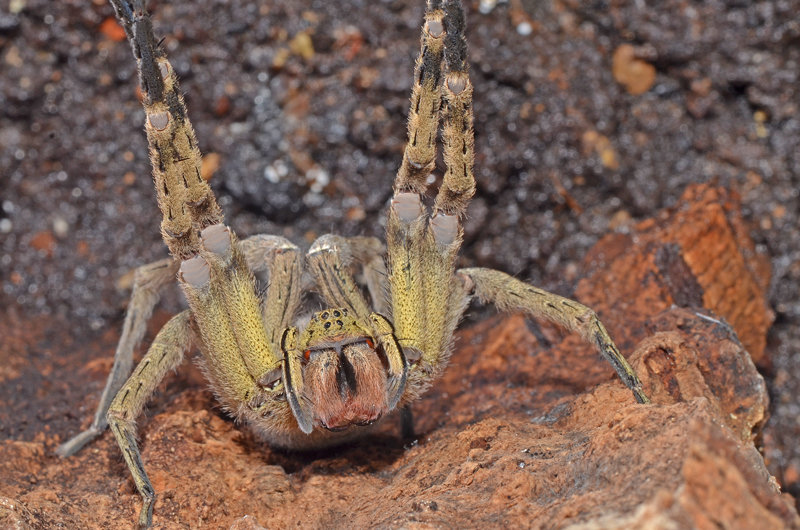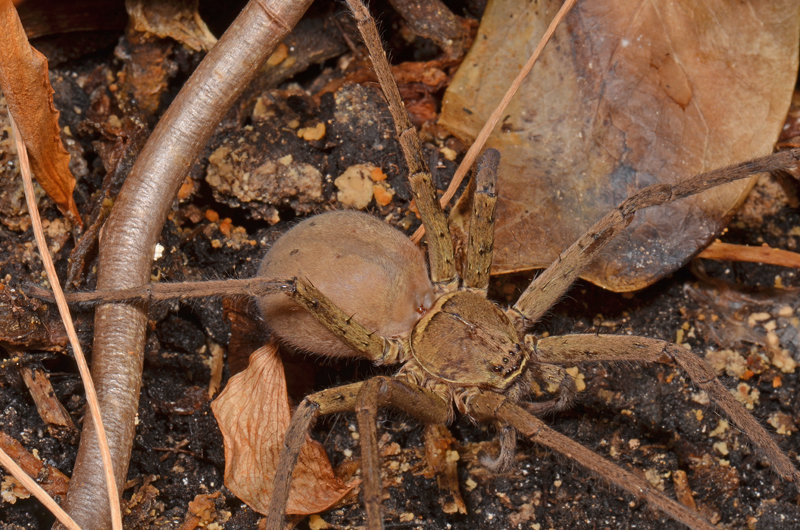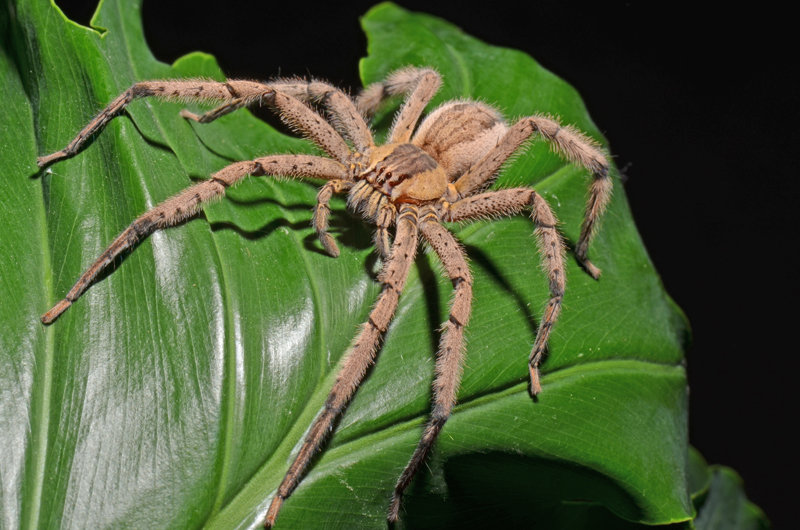"BANANA SPIDERS"
Every so often news report findings of exotic spiders in banana boxes in Germany. Sadly, these are motivated not by the beauty of these rare and large spiders but rather by the opinion, these „banana spiders“ are the most dangerous spiders in the world.
Such news reports often read: “ Spider Alarm! Supermarket evacuated!“ or “Supermarket evacuated after spider bite!“, accompanied by terms like „banana spider“ or “Brazilian Wandering Spider“ and a note, such spiders are highly poisonous and potentially lethal to humans. Sometimes it is added that the spider in question was given to a specialist for identification.
It is a pity that one rarely reads about this event later, for instance, whether it has indeed been the assumed spider species.
In our opinion there is no reason for irritation or panic, in case spiders are observed in supermarkets or presumed spider eggs are found on bananas. Most of the spiders found in banana boxes, supermarkets or warehouses later turned out to be less harmful tropical species or species native to Germany.
The regular use of insecticides, thorough cleaning and continuous cold chains results in only few spiders from the tropics finding their way to us alive. And even if one does, the probability of its belonging to the most poisonous species (Phoneutria nigriventer) is very low; most bananas are not imported from this spider‘s origin: Brazilia. Physical harm after a spider bite is even lower: Banana boxes from the EU, Africa or the Caribbeans cannot contain a spider of the genus Phoneutria. Bananas from Costa Rica, Columbia or Ecuador can harbor the similar-sized but less harmful Phoneutria boliviensis or harmless huntsman spiders of the genera Cupiennius or Heteropoda.
Texts by Claudia Wesseloh & Hubert Höfer
More Information on Phoneutria and other large tropical hunting spiders can be found at www.wandering-spiders.net.
In a broader sense, all banana spiders in Germany are considered spiders and spider species in banana tiers or between banana fruits. Therefore, it is not a name for a certain species nor a scientifically fustified term. Nevertheless, in news reports this term is almost always brought up in connection with the Brazilian Wandering Spider Phoneutria nigriventer. In reality one can find quite a number of spider species in banana plantations, which can possibly be imported to us in fruits as “banana spiders“.
Phoneutria nigriventer is a hunting spider with a body size (without legs) of up to 5 cm. It is native to Argentina, Brazil, Paraguay and Uruguay and belongs to the family Wandering Spiders (Ctenidae). Like most hunting spiders Phoneutria nigriventer has long sturdy legs and is able to move very quickly. Its most astounding characteristic, however, is its being one of the few spider species with a poison harmful to humans. It is also known for its easy irritability, meaning its defensive behavior. When disturbed, it raises its front legs straight up and displays the reddishly haired poison fangs (cheliceres) in a threatening manner. It is this combination of size, speed, toxicity and irritability, which can make an encounter with this species so unpleasant. Caution is indeed advised. It is quite abundant in Eastern Brazilia and there it is regularly encountered in houses. But even there, bites are rare and only few of these instances lead to more serious symptoms or even deaths, since the spiders inject only some of their poison during such defensive bites or even no poison at all (dry bites).
In general, determining a spider to species level is not an easy undertaking for an amateur and should be left to an arachnologist, even more since the eight Phoneutria species – P. bahiensis, P. boliviensis, P. eickstedtae, P. fera, P. keyserlingi, P. nigriventer, P. pertyi und P. reidyi – have similar body appearances (habitus). In order to separate them, adult specimens need to be compared, including their genitalia: the male palpus (pedipalpus) or the female genital plate (epigyne), compare with www.wandering-spiders.net In any case it is helpful to know the origin of the spider (or the banana) because the species in question are restricted to certain regions in Central and South America. Banana tiers from the EU, Africa or the Caribbeans never contain Phoneutria species. Shippings from Costa Rica, Columbia or Ecuador can contain Phoneutria species, but never the most dangerous species: P. nigriventer; it is restricted to Argentina, Brazil, Paraguay and Uruguay.
The Brazilian Wandering Spider Phoneutria nigriventer is native only to Brazil, Uruguay, Paraguay and Argentina. Of these countries only Brazil exports bananas to the EU. According to the European Commission, Brazil produced 41.000 tons (2012), accounting for only 0.8% of the total production of 5 million tons of bananas sold in the EU; therefore it is only in 13th position of all countries shipping to the EU. On the other hand, 62 % of this huge amount originated in Ecuador, Columbia and Costa Rica (Ecuador: 1,307,226 t; Columbia 1,134,371 t; Costa Rica: 770,231 t). Numbers were comparable in the years prior to 2012. Therefore it is unlikely that the most poisonous Phoneutria species P. nigriventer is imported to Central Europe.
Countries producing the majority of bananas, Costa Rica, Columbia and Ecuador, are home to other Phoneutria species. In Costa Rica there is only species, Phoneutria boliviensis; and its poison is not nearly as effective on humans as the one of Phoneutria nigriventer. In Columbia and Ecuador, Phoneutria fera and P. reidyi can be found, next to P. boliviensis. However, both of these species life in the Amazon basin and are only rarely found amongst bananas. Taken together it is most probably Phoneutria boliviensis, when a large spider of up to 4 cm is found, depending on the country of origin.
Central America is also home of other large spiders of the genus Cupiennius (Ctenidae), mostly in Costa Rica and Panama. These are often mistaken for Phoneutria because of their similar appearance and size. But these spiders are harmless; the symptoms after a bite are comparable to a wasp sting. This is also true for the huntsman spider Heteropoda venatoria (family Sparassidae), an originally Asian species, nowadays distributed worldwide in the tropics. Despite the conspicuously different leg arrangement, it is often mistaken for Phoneutria because of its brown color.
A bite by Phoneutria nigriventer is very painful and, depending on the amount of injected poison, can lead to nausea, dizzines, vomiting, increased sweating, a swelling and irritation of the lymphatic vessels; in more serious cases accompanied by high blood preassure and tachycardia (palpitation of the heart). In the most severe cases one experiences muscle spasms, reduced blood circulation, lung edema and a possibly lethal shock-like condition. The application of an antiserum (antidote) is essential in such cases. During intoxication men can even experience painful persistent erections (priapismus).
Because of these symptoms Phoneutria nigriventer is considered very dangerous to humans, even though according to a Brazilian study from 2000, less than 5 % of the 422 recorded cases of bites followed by a severe intoxication led to the application of an antidote. Fatalities are rare, even in Brazil (two according to the study), given the patient does not belong to any of the risk groups, e.g. small children, elder and somehow weakened people. An antidote has been produced for many years by the Instituto Butantan in São Paulo. Because of the priapism, Phoneutria poison is also in the focus of research aiming at the development of potency drugs.
- Bananas - Market Report (2010): European Commission - Directorate General for Agriculture and Rural Development - Directorate C. Economics of agricultural markets (and CMO) C.2. Olive oil, Horticultural products; Brussels, FR/ks - (2011) - Source: ec.europa.eu/agriculture/fruit-and-vegetables/product-reports/bananas/reports/market-2010_en.pdf (Zugriff: 11/2013)
- Bucaretchi, F., Deus Reinaldo, C., Hyslop, S., Madureira, P., De Capitani, E. & Vieira, R. (2000): A clinico-epidemiological study of bites by spiders of the genus Phoneutria. Revista do Instituto de Medicina Tropical de São Paulo 42: 17-21.
- Eurostat EU27, Table 4 (2013): Banana Supply in the EU, European Commission, Directorate -General for Agriculture and Rural Development --- Source: ec.europa.eu/agriculture/fruit-and-vegetables/product-reports/bananas/statistics/supply_en.pdf (Zugriff: 11/2013)
- Jäger, P. & Blick, T. (2009): Zur Identifikation einer nach Deutschland eingeschleppten Kammspinnenart (Araneae: Ctenidae: Phoneutria boliviensis). Arachnologische Mitteilungen 38: 33-36.
- Martins, R. & Bertani, R. (2007): The non-Amazonian species of the Brazilian wandering spiders of the genus Phoneutria Perty, 1833 (Araneae: Ctenidae), with the description of a new species. Zootaxa 1526: 1-36.
- Schmidt, G. (1954): Zur Herkunftsbestimmung von Bananenimporten nach dem Besatz an Spinnen. Zeitschrift für angewandte Zoologie 36: 400-422.
- Schmidt, G. (1956a): Genus- und Speziesdiagnosen neuer, mit Bananen eingeschleppter Spinnen nebst Mitteilung über das Auffinden der Männchen zweier Spinnenarten. Zoologischer Anzeiger 157: 24-31.
- Schmidt, G. (1956b): Zur Fauna der durch canarische Bananen eingeschleppten Spinnen mit Beschreibungen neuer Arten. Zoologischer Anzeiger 157: 140-153.
- Schmidt, G. (1956c): Liste der in den Jahren 1953 and 1954 mit Bananen nach Hamburg eingeschleppten Spinnen aus Franz.-Guinea. Zoologischer Anzeiger 157: 239-241.
- Schmidt, G. (1956d): Die Spinnenfauna der Kanarischen Bananen. Zeitschrift für angewandte Zoologie 43: 237-249.
- Schmidt, G. (1971): Mit Bananen eingeschleppte Spinnen. Zoologische Beiträge 17: 387-433.
- Trejos, A., Trejos, R., & Zeledón, R. (1971): Aracnidismo por Phoneutria en Costa Rica (Araneae: Ctenidae). Revista de Biología Tropical 19: 241-249.
- Valerio, C.E. (1983): Sobre la presencia de Phoneutria boliviensis (F.O.P. Camebridge) (Araneae, Ctenidae) en Costa Rica. Journal of Arachnology 11:101-102.
- Vetter, R. S. & Hillebrecht, S. (2008): Distinguishing two often-misidentified genera (Cupiennius, Phoneutria) (Araneae: Ctenidae) of large spiders found in Central and South American cargo shipments. American Entomologist 54:82-87
